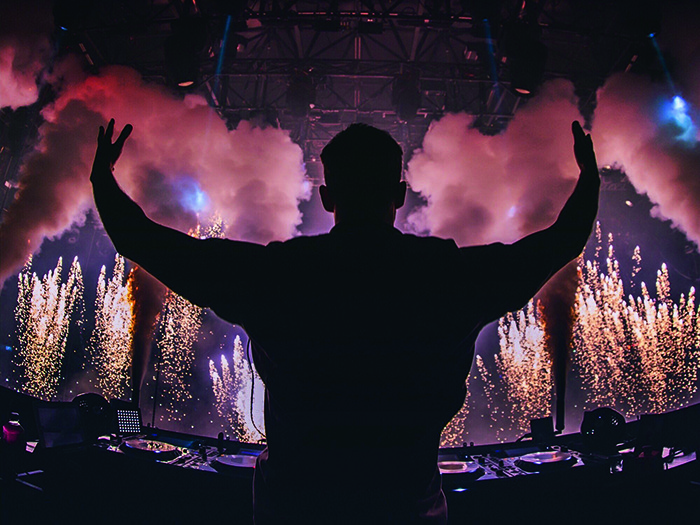Over the British August Bank Holiday more than 70,000 people descended upon Daresbury, Cheshire, for one of the world’s biggest electronic music festivals, Creamfields. The event has grown in size each year, with the Cream organisation constantly raising the bar in terms of line-up and production values. 2016 saw EDM master Calvin Harris, headline the Arc stage on Sunday night. TPi was on site to chat to his crew…
Technical event producer LarMac Live was once again called in by promoters Cream and Live Nation to liaise with the artists and deliver the premium technical production and high quality visitor experience that Creamfields audiences have come to expect. The result saw some of the biggest names in the DJ world play the UK festival. Calvin Harris’ production team, led by Joe Sanchez of LA-based eighteentwentysix was no exception. The crew helped to deliver a jaw-dropping technical feat that included a show design from renowned creative Baz Halpin, a huge laser show and pyrotechnics worthy of an end of summer celebration and an audio package specified to Harris’ ever-changing playlist.
Sanchez told TPi: “I started eighteentwentysix properly once I came off the road after touring with Rihanna [as her Production Manager] three years ago. Our LA office now has 14 full time staff and is expanding. We have a mix of PMs, TMs, production coordinators and stage managers who work in-house. There’s been a real shift in the industry over the last few years and it’s evolved into a more structured environment. The live industry is now so much bigger than the recording side, which still has these giant corporate labels.” This year eighteentwentysix has worked with Zayn, Iggy Azalea, P!nk, Thirty Seconds To Mars, Queen + Adam Lambert, Travis Scott, Missy Elliot and Kygo, not forgetting of course, the biggest DJ on the planet right now, Calvin Harris whom Sanchez describes as “a really nice guy.”
Their working relationship began when Harris supported Rihanna on her Loud tour (TPi cover story, January 2012). In his current Production Director role for Harris’s festival shows, Sanchez works closely with Production and Set Designer, Baz Halpin and the creative team at Silent House. Continued Sanchez: “We built the Coachella show as our festival opener of the year and took the majority of elements from that show for our touring festival rig, including our Creamfields production. It’s amazing to see how DJ production has grown and developed when I look at what Calvin and his team have achieved. They’ve spearheaded the growth of this genre. EDM is here to stay, which is great news for production companies like us!”
For the festival tour, Sanchez opted to use VER for lighting and video, Major Tom for audio consoles, BPM SFX and ER Productions to look after special effects and lasers, respectively, SGPS for automation duties, Sound Moves to handle freight and Fly By Nite for production trucking. Creamfields’ own suppliers include PRG XL Video and Britannia Row Productions.
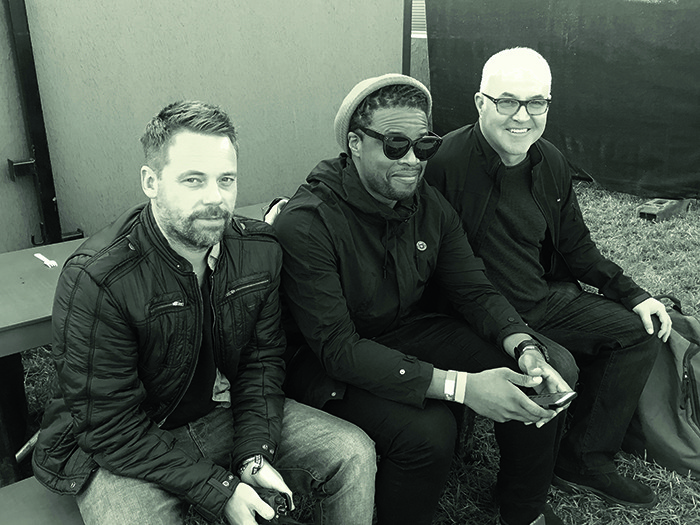
The majority of the day-to-day production management for Harris’ camp is run by Jon Bumgarner, a full time PM at eighteentwentysix. “I handle show advancing, equipment logistics, crew travel and lodging, immigration papers and visas – pretty much anything and everything show-related but during this festival season Coachella was my biggest challenge; I worked 26 hours straight on the first show day and 30 hours straight the second weekend. I’m glad to say we’ve gotten our times down considerably since then!”
Thankfully the production challenges that come with putting on a mammoth festival show didn’t deter this crew, and the Scottish DJ’s performances have gained some well-deserved international press attention. Continued Bumgarner: “It took months of planning and designing, plus a month of physical build time to create the set pieces and the finished article is incredible. Creamfields was a great experience for me; it was my first time there and the festival’s production is run by a great team who took really good care of us. Every show is rewarding in its own way, but we feel especially good after this kind of big event. Plus, it’s always fun to look out from the DJ booth and see a sea of bodies appreciating the show.”
Stage Manager Jim Webb has known Sanchez for 15 years and the pair have since toured the world together with some huge acts, including Rihanna and The Pet Shop Boys. For Harris’ production, Webb is in charge of the load in and on-site set build – the gear for which is transported from festival site to festival site via four Fly By Nite trucks. He said: “We’ve had a really good run,” stated Webb. “Our set looks incredible and really makes you stop in your tracks. We do bring a lot of equipment with us, but that’s because the stage has to have this signature, bespoke look. All Access Staging’s LA office built our custom-made lighting towers and video pods for Calvin’s DJ booth, which look quite special.”
Tommy Rose, Head of Projects Management at All Access Staging and Productions, discussed the company’s involvement with the event: “We have worked with Calvin and his team before with the last time being for the iHeartRadio Jingle Ball in late 2015. For his current festival performance, the design requirement specified a series of eight LED ring towers, each of which could be individually controlled as well as grow onstage while looking as though they were floating. They also needed to be collapsable to fit into a custom carrying case.” There was also a 27ft wide, 15ft tall triangular rolling DJ podium covered in video and four audience LED ring towers that also had to grow. Rose continued: “We completed this task in approximately five weeks from the first cut of aluminium to the time it left our building headed to Coachella. We recorded 1,450 hours amongst our entire fabrication team to accomplish this task.”
The staging itself came courtesy of Acorn Event Structures who have supplied both the North and South Arc Stages for the last two years. This year Acorn proudly launched new Super Structure, The Steel Yard; a 50m wide x 20m high x 90m deep fully weatherproof, interchangeable temporary venue with 100 tonne capacity production loading, which was constructed of HD Breams developed. The impressive stucture was engineered by Acorn and manufactured by Layher.
Crewing specialist Showforce was also on site to help install Harris’ riser, though they had to think on their feet when the time came. Operations Director, Chris Martelly, explained: “Annie Mac would not play in front of the Calvin Harris set, so our crew had to build a makeshift video wall and riser for her to perform on. The crew then had 20 minutes to remove her set to ready the stage for Calvin Harris, which they did in perfect time!”
For the onstage ring towers, All Access designed custom floating LED rings using powder-coated aluminium, and UHMW plastic milled to the exact shape and size needed and then formed into rings. As the entire set was going to be exposed to the elements the company made sure that all components would not get damaged in the rain. The floating look was achieved by using 1/8 inch aircraft cable that was almost invisible once onstage. There were over 350 of these rings throughout the stage towers and the audience field towers.
To aid the transport of the set, All Access designed all the pieces to contain all necessary power and control equipment so that all the stage crew had to do to install it was put it in place and plug it in. When it came time for load out, they simply had to lower the rings into the base, place the lid on them and they were ready to be loaded onto the trucks. “It is important to us to provide not only a product that looks good but to have a product that is easy to use, allowing for rapid deployment,” explained Rose.
The project manager went on to explain that the four audience LED towers presented the biggest challenge for the team having to grow from seven ft to 35ft. “They proved to be challenging. Our engineers explored a multitude of options before we came across a solution that again was both aesthetically pleasing and easy to use.
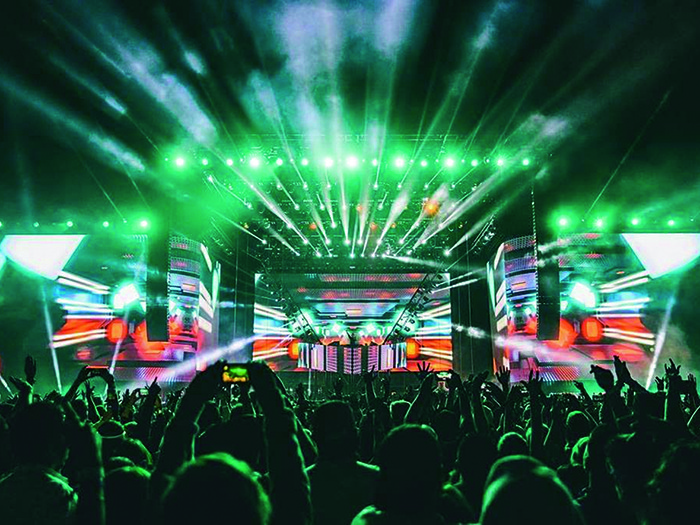
“Normally we would send out concrete ballasts to counteract any forces but as the set was going to go to multiple festivals, ballasts were far too bulky and a pain to travel with. We designed the bases of these towers to hold water ballasts that could be filled onsite and emptied when the show was over saving precious install time and thousands of pounds of shipping weight. The raising of the towers were challenging but we accomplished it by using telescoping rails driven by a hydraulic piston and a series of chains and gears.” The All Access team also designed a control box that would provide all power distribution for the LED rings and power the hydraulic pump.
When it came time to put these units on a plane, all the stage crew had to do was unbolt the tower mast, disconnect a couple connections and push it on. Rose continued: “We worked hand-in-hand with the stage carpenter for this show and were able to give him a set piece that we were both happy with. The DJ podium was a unique scenic element because it had a triangular shape that needed to roll into place and suspends the artist 10ft from the stage floor. We broke the large platform into seven pieces to make it more manageable. Once the DJ podium was all bolted together, the team attached a custom frame that held over 50 video tiles as well as custom laser mounting bars. This entire DJ setup was designed to transport into custom made carts that allowed the stage crew to build it quickly and efficiently.”
Stage Manger Webb gave his final thoughts on the staging: “It’s a very visual show in terms of the set, so it does take about six hours to build the whole thing ready for the show. The most challenging part of the day is the installation of the booth and securing the positioning of the lighting floor package. We also carry a fair bit of rigging and automation from SGPS, which includes eight motors.”
Harris’ touring team is completed by Tour Manager Vizion Jones, Dani Edgren as Backstage Manager and Set Carpenters Roger Cabot, Tom Keane, Christian Dundee, Andy Bews and Cody Osbourne. Monitor Engineer Darren Mullis is also an eighteentwentysix employee who joins FOH Engineer Fab Piazzini on the audio crew. The touring visual department was comprised of Ben Francis, Video Director and Eamonn McKiernan, LD from Earlybird Visual.
CREATIVE DIRECTION
Baz Halpin was approached by Harris’ management team to work on a TV performance for Jimmy Fallon’s Tonight Show which consequently led to securing the Coachella design. This evolved into the touring package. Said Halpin of the impressive design: “We wanted to create a huge LED canvas and be able to sit the DJ booth within that canvas. As the tour travelled to a variety of venues and festivals, it was important that the show could be as flexible as possible. Calvin likes very graphical video content rather than filmed or photorealistic footage, so we took a very digital approach to the design of each of the pieces. Making sure that the lighting and the content were hitting specific dynamics was very important too, so we built the content while we were in production rehearsals to ensure cohesion between the two.
“We wanted to have everything triggered by time code. Calvin DJs live, unlike some other acts – which means that he does not just hit play! He has a series of tracks at his disposal and can mix in and out of some or all of them at any time. The song order often changes, so this made creating a time coded show very tricky. However, with our programming dream team at Earlybird Visual we found a piece of software that allowed us to time code stripe all of the base tracks in Calvin’s archive and have a duplicate DJ rig set up at FOH. This means we could see what tracks he was loading up, and when he mixed them in. Then all we had to do was trigger the Macros at the right time when he dropped the new track. This piece of software also allowed us to track the tempo. When Calvin would speed up or slow down, our video content and lighting cues would also follow to ensure the dynamics were always in sync. To the best of our knowledge, this was the first time this idea had been done effectively.
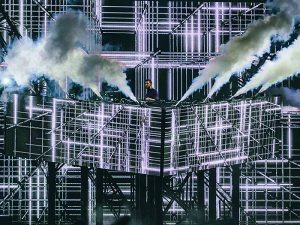
“Calvin’s shows are a sensory experience. He wanted the audience to feel the power of the lighting and video almost subconsciously, so we utilised the power of the screen and lighting rig in tandem. Often we would just strobe the screen at full intensity, or let it drop out for a split second and allow the lighting to take over to create a powerful effect. It’s great to work with an artist that has such commitment to the end product – both musically and visually. Calvin is engaged throughout every step of the process and I think the end result reflects that,” he concluded.
Harris’ Lighting Operator Eamonn McKiernam added: “We have had to squeeze in and adapt our production into each of the festivals while still keeping our overall look and idea of the show. Each festival varied greatly in what they were providing for lighting fixtures, fixture layout and overall size of the stage. We looked at each festival as a new show, and spent the time pre-programing each show as much as we could so that each one looked the best that it could. As Calvin’s set evolved and grew each festival, so did our production and our programming. Each show we strived to have best show possible.
“Calvin wanted his show to be a large production no matter where we went, or what festival we were doing. He wanted to give the best show experience possible at all times. To achieve that we pulled out all the stops to give it everything that we could. The set that he plays is very dynamic and we made sure to have the production followed that. Our video content alone is enough to be a dramatic visual show, but add on top of that lighting, lasers and special effects and we have a very varied production.”
The rig for Creamfields was a mix of what the production had advanced and what the festival specified. McKiernan talked through some of the highlights of the rig: “The main workhorse for the show are the beam / hybrid fixtures such as the Clay Paky Sharpy and Mythos fixtures, as well as Solaris Flare strobes. The rest of the rig is finished with Vari-Lite VL3500 washes, which are a standard fixture in any festival rig and are powerful enough to cut through all the video elements that are on this stage, as well as LED RGB blidners that we match to the programming of the Flares. Everything is laid out so that it can be used solely by itself, evenly across the whole rig. As we don’t use every fixture for every song, having everything spread across the whole stage was very important.
“At FOH we travel with two full size MA Lighting grandMA2 consoles, all networking racks, and our own Resolume rack. I have tried every console by now, and will only use an MA2 for my shows. Its stability, power and flexibility are unmatched to anything else. We have to be able to go from a programmed song to a punt page all while controlling video content and back to a programmed song seamlessly. The show is made up of pre-programmed songs but also a good amount of punting. This gives Calvin the ability to play what he wants, and isn’t hindered by what we have already programmed or planned for. Since we have only done a handful of festivals this summer, Calvin wanted to make sure every show was a different. The show can seem overwhelming to an outside observer, but with all the preparation that we put into each show, things run pretty smoothly. Our preparation and the people who make up our production team is what makes our show so successful.
He concluded: “Creamfields was the closest we have come to replicating the Coachella festival show we did in terms of the amount of lighting fixtures and video pixels on stage. With every artist trying to achieve something new and something fresh, its hard to stay ahead of that.”
IN-HOUSE VISUALS
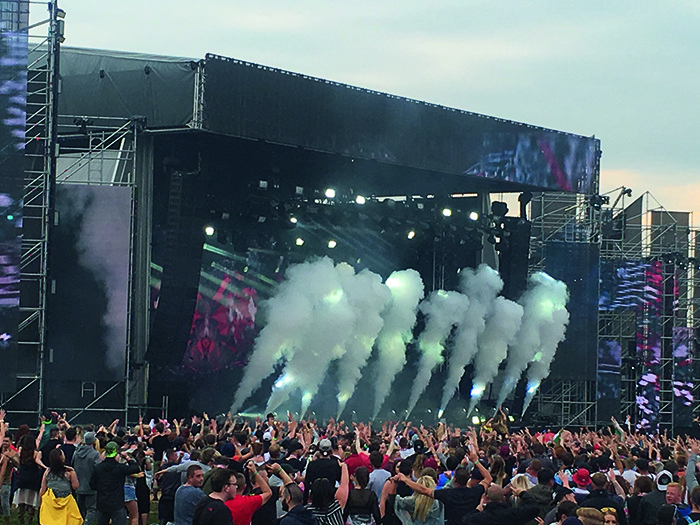
To help LarMac Live deliver the largest Creamfields to date, PRG XL Video were brought in to supply video, lighting and rigging across the two vast main stages Arc – where Harris played – and Horizon, together with video across six more stages around the 900-acre site.
PRG XL Video’s Head of Rigging Services, Q Willis, oversaw a team supplying the rigging across stages CF01 – Arc, and CF02 – Horizon. He explained: “During the design process we worked closely with Charlotte Scott and Igor Pacejs from Acorn Events who built the stage structures, ensuring that the rigging for video, lighting and audio was accurately assessed/plotted and installed as per the agreed plots.”
Both of the two main stages – Arc and Horizon – had new designs this year. Arc was a curved structure, wider than last year’s North Stage, extending around the audience to the sides and giving them a truly immersive experience. Horizon was a mix of varied height towers clad with LED, giving the former South stage a completely new look. For the Arc stage Willis’ team, led by Chris ‘Karrit’ Harris and Cleveland Brown, installed a truss system suitable for the opening show headliners Alesso. That system then formed the mothergrid for the second day’s headliner, Axwell /\ Ingrosso’s 28 Kinesys hoists, and was then used for Calvin Harris on the final night with the addition of touring animation.
A similar design was installed on the Horizon stage, with the team led by Stav Hanks and Kim Klusters, and that allowed them to efficiently change Avicii’s design into Tiesto’s overnight. Willis explained: “By producing individual, accurate show artist plots, that allowed us to keep overnight changes to a minimum and costs down. We used the first rig as the mothergrid for the following nights’ headliners, which included hanging the Kinesys system from for Axwell /\ Ingrosso’s set on Saturday, which was operated by Pete MacDonald.”
“With PRG XL Video supplying rigging on two of the stages, and working alongside our own lighting and video teams, this really enabled us to plan ahead and work out a lot of the potential on-site issues in the design stages. That meant we could create an efficient plot which kept the on-site work to manageable levels.”
PRG XL Video Account Manager Gordon Torrington oversaw the lighting side of the project. He worked closely with LarMac Live to deliver lighting on the Arc and Horizon stages. The festival’s aim is to deliver the lighting requirements as specified in each artists’ rider, which enables them to create a unique look for each of their sets, hence Harris’ full throttle, unique finale. On the Arc stage Torrington worked with FOH Operator, Chris Scott, and Lighting Crew Chief, Aidan MaCabe, to specific the lighting for the giant curved wings, creating a look that would complement the artists’ on-stage lighting setups.
For the Horizon stage, the lighting design was led by the artists’ requirements, and Torrington worked with Crew Chief, Luke Jackson, and FOH Operator, Adam Power. The design for the Horizon stage utilised 100 of PRG XL’s powerful Icon Beam fixtures, ideal for an event of this size and scope. The team also supplied a WYSIWYG suite on site at the festival, allowing the artists’ lighting designers to test and refine their set-ups before the live sets. A team of 14 lighting crew worked across the two stages, and nine trucks of lighting and rigging technology, including well over 1,000 lighting fixtures, were supplied to the Daresbury site. This was the second year PRG XL Video has supplied lighting and rigging to the festival.
The largest element of PRG XL Video’s contribution to the Creamfields event was video, with LED screens of all shapes and sizes were used across eight stages. This is the sixth year PRG XL Video has supplied video to Creamfields, working with the team at LarMac Live to satisfy the ever-more impressive designs each year. PRG XL Video’s Account Managers Paul ‘Macca’ McCauley and Jay Mobbs-Beal oversaw the video requirements across the stages, working to specify thousands of square metres of LED, media servers, and screen management systems, which filled 13 trucks with video technology. Macca and Mobbs-Beal were supported on site by Video Project Manager, Ian Jones, who was instrumental in ensuring all the video elements worked to the event’s high specification.
With 250 artists and VJs appearing across the weekend one huge consideration was ensuring that their video content was correctly formatted for the wide variety of screen sizes and orientations. On site, a team led by Stuart Merser was on-hand to assist the artists and VJs with their content, getting it fully working with the Resolume media servers used across the Creamfields stages.
To help artists prepare for the show, PRG XL Video’s Erica Frost created Resolume output maps which were sent out before the event alongside standard pixel and content maps. These allowed artists VJs to build their content specifically for the unique Creamfields video layouts. Creamfields continues to grow each year, regularly winning the Best Dance Event category at the Festival Awards. With this in mind, the two main stages had new designs for 2016. The Arc stage used columns of LED on either side of the stage to create the curved arena, as well as using LED for headers, backdrops, risers and DJ booths. Video Crew Chief for stage Arc was Stevie Marr.
On Horizon, the new design used multi-facetted towers to create an effect much like a small city built from LED. Horizon was looked after by Crew Chief Al Bolland across the weekend. In CF3 – Mega Arena – the largest of the tent stages a multi-layered effect was created with LED backdrops, risers, DJ booths, and even tent poles clad in LED.
For the CF04 – Steel Yard LED triangles were flown above the crowd on a Kinesys system which enabled the shapes to move and tilt. The 3m high stage was clad with LED at the front and paired with a 12m wide backdrop, both of which were covered with ROE MC-12 LED. The stage was flanked by four columns each side built from the innovative ROE MC-18 Hybrid LED. The design of the Steel Yard was a new idea from Creamfields, and is set to be used for an upcoming show in Liverpool later this year.
Stage CF5, the Curve arena, was created using multiple square LED screens to build a curve, reminiscent of stacks of TV screens, whilst CF6 used LED towers, risers and backdrop. Stages CF7 and CF8 both used LED for backdrops, risers and DJ booths. In CF07 used additional LED from PRG XL Video to further enhance the show. This included additional ROE MC-7 which was used in pre-fabricated blocks for their production.
In total well over 17 million LED video pixels were seen by the audiences across the weekend festival, formed into a variety of different shaped and sized screens. Macca commented: “Creamfields is one of the more challenging festivals we work on each year – purely because of the amount of equipment we ship to site. I was particularly impressed with the design of the Steel Yard structure which vastly improved the amount of weight loading compared to a traditional festival tent. The team from Creamfields and producers, LarMac Live, strive to make the show bigger and more impressive every year, and we’re very proud to have played a part in helping the festival grow over the six years we’ve been supplying video to them!”
SPECIAL EFFECTS
Back on Planet Harris, ER Productions worked closely with Halpin to bring his stunning laser concept to life. Operated by Eric Marchwinski, the show was controlled using an MA Lighting grandMA2 console and a Pangolin Beyond bespoke software solution. ER Productions collaborated with Pangolin’s development team to create new features for the software, which enables the lasers to be controlled through the lighting desk. Being part of a well planned and executed show meant that the visual aspects of the production looked fantastic.
The lasers, which were seamlessly integrated into the performance by ER, added excitement at key moments throughout. A total of 21 lasers and Beambursts lined the down stage edge, while Harris’ DJ riser was populated with 20 Laserblades, a technique that was also used at Coachella. In addition to providing crucial support to the lighting operator, ER’s Andrew Turner operated the smoke package live on the night.
Marc Webber, Co-founder of ER Productions commented: “We delivered a huge laser package for Calvin Harris’s Creamfields set. To achieve the look, we used our Beamburst and Laserblade lasers combined with scanning systems including the Excellent 21 and Phaenon X Pro. As always, it has been a pleasure working with Baz Halpin to make Calvin’s 2016 summer festival tour dates look incredible.”
Andrew Turner added: “Running the Beyond show file in server mode gives lighting operators simultaneous control of laser and lighting fixtures, which is a huge leap forward. Skilful programming and operating on the night enabled the seamless integration of lighting, video, lasers and pyrotechnics.
For pyrotechnic and special effects duties, Sanchez and Halpin brought in Lancashire-based BPM SFX to add a further flare to the show. BPM SFX Project Manager across the entire site was Liam Haswell said of the production: “We provided, 18 Co2 jets with a massive 90 cylinders of Co2, six stadium confetti blasters, eight X-Treme Streamer Cannons, 12 G flames, 10, 20m Inferno Flames and over 1,000 units of stage and display pyrotechnics for his headline performance at Creamfields. We took the existing show special effects and added in elements to compliment the stage design at Creamfields He wants to put on a show for the audience both visually and audibly. Special effects are a big part of that so he takes them seriously. A lot of thought went into designing this show. It was a brilliant way to close the festival – with a big bang!”
The BPM SFX team utilised a Galaxis Wireless Pyro Firing System and a bespoke control rack.
AUDIO
Fab Piazzini has handled Harris’ FOH sound for the past two and a half years. He described the challenges that come with mixing a live DJ: “The expectations are very high and the chances of failure have to be zero. With a standard band you might have 56 inputs, and if one fails you can blend the problem away, this cannot happen if you’re only working with two inputs. My approach to a DJ gig is exactly the same as when it’s a band mix: tune the PA to my needs and focus 100% on the task at hand. The difference with a band is mixing lots of inputs, whereas with a DJ gig it’s more like mastering but as EDM music is already highly mastered, so the RMS is really high, which in turn means the systems are always working really hard to reproduce the waveforms. The same amount of ‘geekery’ goes into both processes!” he laughed. “I don’t just set a level and that’s it; I dig deep into the dynamic equalisation as I am constantly battling with the non-linearity of supposedly linear speakers. Basically, when a box is pushed to its limit it will not behave consistently across the whole spectrum. I need to correct this in order to keep a good level of consistency.”
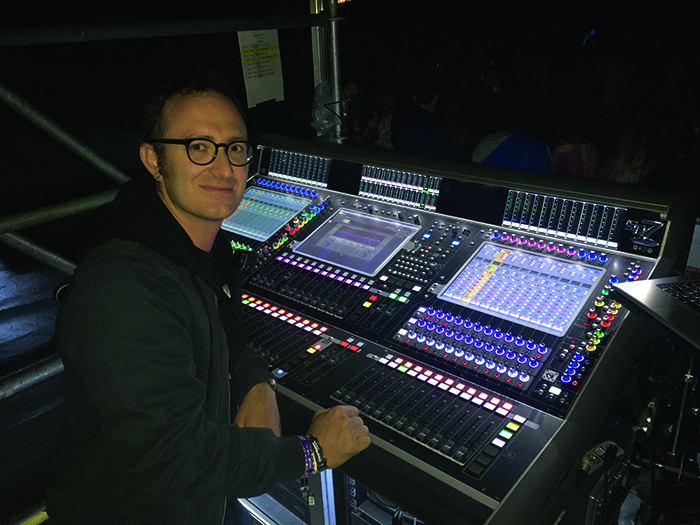
According to Piazzini, Harris’ sound needs to be the “best and biggest stereo system you can get,” meaning he doesn’t look for a ‘live’ sound as such, but for “the highest fidelity possible.” He continued: “You need to be able to appreciate every little nuance in the tracks. It also needs to get the crowds dancing!”
For his FOH setup, Piazzini relies on a DiGiCo SD7 console, which he describes as “the only true redundant console on the market”, Waves plugins – mainly C6, Vitamin, L2 and RBass – and a 10eazy system to “give a projection of the show’s SPL so that I can adhere to local regulations and squeeze out the maximum volume allowed!”
Major Tom provided console and monitoring equipment for the festival-touring rig. Said Piazzini: “It’s a great company with lovely people and all the right gear for our show; the Meyer Sound Leopard box is the only option for our DJ booth.”
Over in monitor world Darren Mullis is also operating an SD7. He added: “Most guest engineers are happy to see these desks on site. DiGiCo is the only console manufacturer I really feel comfortable mixing on these days – I know they sound great and I trust them to do the job. The booth will look after itself once it’s up and running but when dealing with guests on stage I have to be confident and incisive so that they feel comfortable before they perform in a different environment than one they may be used to.”
Harris’ booth system is made up of two Meyer Sound 900-LFC’s low frequency elements and six Meyer Sound LEOPARD compact linear line array speakers powered straight from the booth (via a Pioneer DJM-900 mixer through a Meyer Sound Galileo Callisto 616 array processor). “Either I will put a mix together or guest engineers can look after their own clients,” said Mullis who also utilises Sennheiser SR2000 Series transmitters and Shure Axient systems in the US, and Shure UFH-R receivers outside the US. “We’ve kept it nice and simple with a Shure SM58 microphone head and a choice of SM58’s, KSM9’s or SM58’s for our guest vocalists.” Mullis gave his final thoughts post Creamfields performance: “Thanks to the diligent and amiable team at both VER and Major Tom, the summer really has been a splendid experience for us.”
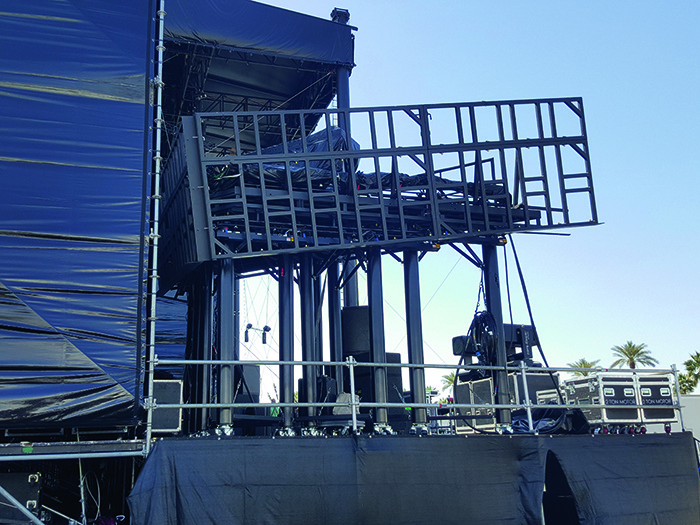
Britannia Row Productions took on the audio requirements for CF01 and CF02 along with the Steel Yard using an L-Acoustics K1/K2 system. Dave Compton was Project Manager. “At events like this, teamwork is always the most important factor. Britannia Row Productions has been providing audio for Creamfields for some years now and we have a good relationship with production which goes a long way to making the weekend run smoothly. There are always challenges – the weather can, and does, often work against us – but that’s the nature of festivals. Laurie Fradley was our overall Crew Chief and we had three distinct crews so each stage worked as an individual event.’
The Steel Yard Arena, as the name suggests, is a stage designed to embrace the audience in a visual and audio experience. Substantial numbers of L-Acoustics K1’s, K2’s, KARAs, ARCs supported by KS28 Subs were more than up to the job with the directivity of the K Series enabling the required SPL without spill, an important element on a site with multiple stages.
The north and south stages featured identical systems with L-Acoustics K1 and KS28 subs. For control at FOH was a DiGiCo SD10 and a Yamaha QL1 console on stage. The south stage saw Avicii headline on Saturday night and perform his last ever UK show. Avicii’s FOH Engineer Wayne (Rabbit) Sergeant was on duty for the show. “Working with Britannia Row Productions is never less than a complete pleasure. The service we get as a visiting act, whether or not we are the headline act is second to none. I admit to being a long term L-Acoustics fan and this rig didn’t disappoint. I’ve used the new KS28’s this season and been really impressed with their performance; they continue to amaze me with the amount of detail you can hear in the mix, their tone, the effortless power handling and control. It all results in a very natural sound.”
The Steel Yard was a new venue for Creamfields and Britannia Row Productions alike. Specially commissioned by LarMac Live, the Steel Yard has an enviable capacity for festival goers and has a ceiling at of twenty metres at its apex. This allows for weather-proofed festival-sized entertainment and enclosed audio, lighting and AV effects. “As it is a steel structure with a high roof clearance we were obviously concerned that sound reinforcement would be an issue,” explains Greenway, “but the Britrow crew did their magic and the room sounded great. The concept of the Steel Yard was something of a journey into the unknown for us – it is the first structure of its kind in Europe – so having a system sound so dynamic and alive without reflective reverberation was a massive affirmation of that decision. I can guarantee you will be seeing more of the Steel Yard very soon.
‘The service and level of professionalism we get from everyone at Britannia Row Productions is exemplary. As Production Manager, I couldn’t ask for anything more.”
TPi
Photos: Conor McDonnell, TPi and All Access Staging
www.creamfields.com
https://larmaclive.com
http://calvinharris.com
http://eighteentwentysix.com
www.britanniarow.com
http://allaccessinc.com
www.prg.com/uk
http://bpm-sfx.com
www.er-productions.com
www.ver.com
www.acorn-events.com

